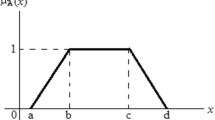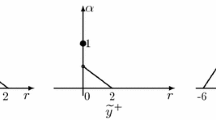Abstract
In this paper, we have established appropriate duality relations for a general nonlinear optimization problem under fuzzy environment, taking exponential membership functions and using the aspiration level approach. A numerical example has also been shown to justify the results presented in the paper.
Similar content being viewed by others
1 Introduction
Zadeh in 1965 introduced fuzzy set theory by publishing the first article in this area. He generalized the classical notion of a set and a proposition to accommodate fuzzyness. This has been applied in diverse fields such as machine learning, multi-attribute decision making, supply chain problems, management sciences, etc. Fuzzy control, which directly uses fuzzy rules, is the important application in fuzzy theory. Fuzzy set theory is also applicable in the real life case like controlling smart traffic light. The controller is designed in such a way that it changes the cycle time depending upon the densities of cars behind red and green lights.
The fuzzy set theory provides various logical operators that allow the aggregation of several criteria to just one criterion. These operators can be evaluated with respect to axiomatic requirements, numeric efficiency robustness, degree of compensation among the criteria, and ability to model expert behavior.
Bellman and Zadeh [1] proposed the idea of decision making in fuzzy environment. After the pioneering work on fuzzy linear programming problems (FLPP) in Tanaka et al. [2] and Zimmermann [3], several kinds of (FLPP) along with the different solution methodologies have been discussed in the literature. Many researchers, including Lai and Hwang [4], Shaochang [5], Buckley [6, 7], and Negi [8], have considered the problems where all parameters are fuzzy. Lai and Hwang [4] assumed that the parameters have a triangular possibility distribution. Using multiobjective linear programming methods, they provided an auxiliary model related to it.
Rodder and Zimmermann [9] were the first who studied the duality of (FLPP), considering the economic interpretation of the dual variables. After that, many interesting results regarding the duality of (FLPP) have been investigated by several researchers [10–18]. Zhang et al. [19] investigated the duality theory in fuzzy mathematical programming problems with fuzzy coefficients. Ovchinnikov [20] characterized Zadeh’s extension principle in terms of the duality principle. Introducing the concept of convex fuzzy variables for fuzzy constrained programming, Yang [21] proved a convexity theorem with convex fuzzy parameters and a duality theorem for fuzzy linear constrained programming. Later on, Farhadinia and Kamyad [22] extended the duality theorems for the crisp conic optimization problems to the fuzzy conic programming problems based on the convexity-like concept of fuzzy mappings and the parameterized representation of fuzzy numbers.
The paper is organized as follows. In Sect. 2, we construct a general fuzzy nonlinear programming problem and formulate its Mangasarian type dual. Further, we prove duality theorems using exponential membership functions under convexity assumptions. In the next section, we illustrate a numerical example.
2 Definitions and preliminaries
In the crisp sense, a general nonlinear primal-dual pair can be expressed as follows:
Primal Problem (MP)
Dual Problem (MD)
where \(X\subseteq R^{n}\), \(x, w \in\mathbb{R}^{n}\), \(u \in\mathbb {R}^{m}\), \(f:R^{n}\rightarrow R\), \(g_{i}:R^{n}\rightarrow R\), \(i=1,2,\ldots,m\).
Let the aspiration levels corresponding to the objective function of primal (MP) and dual (MD) be denoted by \(z_{0}\) and \(w_{0}\), respectively.
Now, the above crisp pair (MP) and (MD) can be described in the fuzzy sense as the following pair (MP̃) and (DD̃):
Primal Problem
Dual Problem
where “≳” and “≲” are the representations of inequalities “≥” and “≤” in the fuzzy sense, respectively, and have interpretation of “essentially greater than” and “essentially less than” in the sense of Zimmermann.
The exponential membership functions associated with the objective function and the ith constraint, \(i=1,2,\ldots,m\), are as follows:
and
where \(F=\alpha((f(x)-z_{0})/p_{0})\), \(G_{i}=\alpha_{i}(g_{i}(x)/p_{i})\), and α, \(\alpha_{i}\), \(0<\alpha, \alpha_{i}<\infty\) are fuzzy parameters, also called shape parameters as they measure the degree of vagueness. The constants \(p_{0}\), \(p_{i}\) (\(i=1,2,\ldots,m\)) are the allowed change or violations corresponding to the objective function and the constraints of (MP), respectively.
The set of feasible solutions of the fuzzy nonlinear programming problem (MP̃) is denoted and defined as follows:
It represents the decision space with respect to the fuzzy constraints of (MP̃). Its membership function \(\mu_{\widetilde{D}} : R \rightarrow[0, 1]\) can be determined from the membership functions of individual fuzzy sets as follows:
For every \(\hat{\mu}_{0}\), \(\hat{\mu}_{i}\) lying between 0 and 1, there exist unique \(\hat{p}_{0}\), \(0<\hat{p}_{0}<p_{0}\) and \(\hat{p}_{i}\), \(0<\hat{p}_{i}<p_{i}\) such that
Denote
Let X be the universe, whose generic elements are the sets \(\mathit{FR}(\hat {p}_{0},\hat{p})\). Then we define a membership function \(\mu_{\widetilde {\mathit{FR}}}: X\rightarrow[0, 1]\) by \(\mu_{\widetilde{\mathit{FR}}}(\mathit{FR}(\hat{p}_{0},\hat {p}))=\min\{\hat{\mu}_{0},\hat{\mu}_{1},\ldots,\hat{\mu}_{m} \}\). Therefore, the set D̃ can also be written as
Here, D̃ is a fuzzy set whose elements are the set of points in \(R^{n}\) which are generated with the unique aspiration level \(z_{0}+\hat{p}_{0}\) and \(\hat{p}_{i}\).
Now, following Bellman–Zadeh’s maximization principle and using the fuzzy membership functions defined above, the crisp equivalent of (MP̃) can be formulated as follows:
where \(F=\alpha((f(x)-z_{0})/p_{0})\) and \(G_{i}=\alpha_{i}(g_{i}(x)/p_{i})\), \(i=1,2,\ldots,m\).
The above problem can be equivalently expressed as follows:
Similarly, if the constant \(q_{0}\) denotes admissible violations of the objective function of the problem (DD), then the crisp equivalent of (DD̃) can be obtained as follows:
where \(H=\beta((w_{0}-L(w,u))/q_{0})\).
This can be further re-written as
where β is a shape parameter that measures the degree of vagueness of the objective function of (DD̃).
Theorem 2.1
For each feasible point of the problem (MP̃) there exists ξ, \(0 \leq\xi\leq1\) such that \((x,\xi)\) satisfies the constraints (1)–(3) of (PP-1).
Proof
Let \(x\in\widetilde{D}\). Then there exist some \(\hat {p}_{0}\), \(0 \leq\hat{p}_{0} \leq p_{0}\), \(\hat{p}_{i}\), \(0 \leq\hat{p}_{i} \leq p_{i}\), \(i=1,2,\ldots,m\), such that \(x\in \mathit{FR}(\hat{p}_{0},\hat{p})\) and its membership value is given by \(\mu_{\widetilde{\mathit{FR}}}(\mathit{FR}(\hat{p}_{0},\hat {p}))=\min\{\hat{\mu}_{0},\ldots,\hat{\mu}_{m}\}\).
Now, since \(x\in \mathit{FR}(\hat{p}_{0},\hat{p})\), therefore we have
For some \(\xi_{0}, \xi_{i}\in[0,1]\), let
Hence, inequality (7) becomes
where \(\xi=\min(\xi_{0},\xi_{1},\ldots,\xi_{m})\). Therefore, \((x,\xi)\) is feasible for (PP-1). Hence the result. □
Theorem 2.2
Suppose \(x_{0}\) and \((x_{0},u_{0})\) are the feasible solutions of (MP) and (MD), respectively. If the corresponding objective value of (MP) fully (partially) satisfies the goal \(z_{0}\), then the weak duality theorem between (MP̃) and (DD̃) holds (partially holds). That is, \(z_{0}\geq w_{0}\) (\(z_{0}+p_{0}\geq w_{0}-q_{0}\)).
Proof
By the weak duality result between (MP) and (MD), we have
Since \(x_{0}\) is a feasible solution of (MP), therefore we get
Hence \(\mu_{i}(g_{i}(x_{0}))=1\), ∀i.
If \(f(x_{0})\) fully satisfies the goal \(z_{0}\), then \(f(x_{0})\leq z_{0}\). Therefore
Also, the membership value of \(L(x_{0},u_{0})\),
So, \(L(x_{0},u_{0})\geq w_{0}\).
Combining this with (8) yields
Now, if \(f(x_{0})\) partially satisfies the goal \(z_{0}\), then \(z_{0}\leq f(x_{0})\leq z_{0}+p_{0}\). Then
That is,
Hence
This yields
This completes the proof. □
Theorem 2.3
(Modified weak duality)
Let \((x,\xi)\) and \((w,u,\psi)\) be feasible solutions for (PP-1) and (DP-1), respectively. Further, assume that the functions f and g are convex at w. Then
Proof
Multiplying the constraint (2) of (PP-1) by \(u_{i}\geq0\) and further adding all the \(`m'\) inequalities, we obtain
By the convexity of f and g at w, we have
and
Employing \(u\geq0\) in (11) and then adding with inequality (10), we get
Finally, using (5) in the addition of (9) and (12), we have
Hence the result. □
Theorem 2.4
Let \((\bar{x}, \bar{\xi})\) and \((\bar{w},\bar{u},\bar{\psi})\) be feasible solutions for (PP-1) and (DP-1), respectively. Assume that the following conditions hold:
Then \((\bar{x}, \bar{\xi})\) and \((\bar{w},\bar{u},\bar{\psi})\) are the optimal solutions to (PP-1) and (DP-1), respectively.
Proof
Let \(( x,\xi)\) and \((w,u,\psi)\) be feasible solutions for (PP-1) and (DP-1), respectively. Then
Using hypothesis (i) gives
It follows that \(( \bar{x},\bar{\xi}, \bar{w},\bar{u},\bar{\psi})\) is the optimal solution to the following optimization problem whose maximum value is zero:
Further, hypotheses (i) and (ii) yield
Since \(\bar{\xi}, \bar{\psi}\leq1\), therefore each term in the above expression is nonpositive, which sums up to zero. Hence
Since
therefore
which implies \(\xi\leq\bar{\xi}\). Similarly, we obtain \(-\psi\geq-\bar{\psi}\). This proves the result. □
3 Numerical illustration
Consider the following primal-dual pair:
and
Taking an exponential membership function in the primal problem (P) and the dual problem (D), the corresponding problems (PP-1) and (DP-1) become:
and
where \(p_{0}=p_{1}=2\), \(z_{0}=1\), \(\alpha=2\), \(\alpha_{1}=1\) and \(q_{0}=1\), \(\beta=2, w_{0}=1\). Using a software MAPLE 12, the optimal solutions of (FP) and (FD) are \(x^{*}=0.3190 \), \(y^{*}=0.6910\), \(\xi^{*}=1 \) and \(\psi^{*}= 0.1016\), \(u^{*}= z^{*}=0.50\), \(w^{*}=0\), respectively. Since all the assumptions of Theorems 2.3 and 2.4 are satisfied for the above problems, hence at these points the results of the theorems can easily be verified.
References
Bellman, R.E., Zadeh, L.A.: Decision making in a fuzzy environment. Manag. Sci. 17, 141–164 (1970)
Tanaka, H., Asia, K.: Fuzzy solution in fuzzy linear programming problems. IEEE Trans. Syst. Man Cybern. Syst. 14, 325–328 (1984)
Zimmermann, H.J.: Fuzzy programming and linear programming with several objective functions. Fuzzy Sets Syst. 1, 45–55 (1978)
Lai, Y.J., Hwang, C.L.: A new approach to some possibilistic linear programming problem. Fuzzy Sets Syst. 49, 121–133 (1992)
Shaocheng, T.: Interval number and fuzzy number linear programming. Fuzzy Sets Syst. 66, 301–306 (1994)
Buckley, J.J.: Possibilistic linear programming with triangular fuzzy numbers. Fuzzy Sets Syst. 26, 135–138 (1988)
Buckley, J.J.: Solving possibilistic linear programming problems. Fuzzy Sets Syst. 31, 329–341 (1989)
Lai, Y.J., Hwang, C.L.: Fuzzy Mathematical Programming Methods and Applications. Springer, Berlin (1992)
Rodder, W., Zimmermann, H.J.: Duality in fuzzy linear programming. In: Internat. Symp. on Extremal Methods and Systems Analysis, University of Texas at Austin, pp. 415–427 (1980)
Bector, C.R., Chandra, S.: On duality in linear programming under fuzzy environment. Fuzzy Sets Syst. 125, 317–325 (2002)
Bector, C.R., Chandra, S., Vidyottama, V.: Matrix games with fuzzy goals and fuzzy linear programming duality. Fuzzy Optim. Decis. Mak. 3, 255–269 (2004)
Bector, C.R., Chandra, S., Vijay, V.: Duality in linear programming with fuzzy parameters and matrix games with fuzzy pay-offs. Fuzzy Sets Syst. 146, 253–269 (2004)
Liu, Y., Shi, Y., Liu, Y.H.: Duality of fuzzy MC2 linear programming: a constructive approach. J. Math. Anal. Appl. 194, 389–413 (1995)
Ramik, J.: Duality in fuzzy linear programming: some new concepts and results. Fuzzy Optim. Decis. Mak. 4, 25–39 (2005)
Verdegay, J.L.: A dual approach to solve the fuzzy linear programming problems. Fuzzy Sets Syst. 14, 131–141 (1984)
Wu, H.C.: Duality theory in fuzzy linear programming problems with fuzzy coefficients. Fuzzy Optim. Decis. Mak. 2, 61–73 (2003)
Richardt, J., Karl, F., Miller, C.: A fuzzy dual decomposition method for large-scale multiobjective nonlinear programming problems. Fuzzy Sets Syst. 96, 307–334 (1998)
Sakawa, M., Yano, H.: A dual approach to solve the fuzzy linear programming problems. Fuzzy Sets Syst. 67, 19–27 (1994)
Zhang, C., Yuan, X.H., Lee, E.S.: Duality theory in fuzzy mathematical programming problems with fuzzy coefficients. Comput. Math. Appl. 49, 1709–1730 (2005)
Ovchinnikov, S.: The duality principle in fuzzy set theory. Fuzzy Sets Syst. 42, 133–144 (1991)
Yang, X.: Some properties for fuzzy chance constrained programming. Iran. J. Fuzzy Syst. 8, 1–8 (2011)
Farhadinia, B., Kamyad, A.V.: Weak and strong duality theorems for fuzzy conic optimization problems. Iran. J. Fuzzy Syst. 1, 143–152 (2013)
Acknowledgements
The authors wish to thank the referees for several valuable suggestions which have considerably improved the presentation of the paper.
Funding
This research is supported by the King Fahd University of Petroleum and Minerals, Dhahran, Saudi Arabia, under the Internal Project No. IN161058.
Author information
Authors and Affiliations
Contributions
All authors contributed equally to this work. All authors read and approved the final manuscript.
Corresponding author
Ethics declarations
Competing interests
The authors declare that they have no competing interests.
Additional information
Publisher’s Note
Springer Nature remains neutral with regard to jurisdictional claims in published maps and institutional affiliations.
Rights and permissions
Open Access This article is distributed under the terms of the Creative Commons Attribution 4.0 International License (http://creativecommons.org/licenses/by/4.0/), which permits unrestricted use, distribution, and reproduction in any medium, provided you give appropriate credit to the original author(s) and the source, provide a link to the Creative Commons license, and indicate if changes were made.
About this article
Cite this article
Gupta, S.K., Dangar, D., Ahmad, I. et al. Duality in nonlinear programming problems under fuzzy environment with exponential membership functions. J Inequal Appl 2018, 218 (2018). https://doi.org/10.1186/s13660-018-1812-x
Received:
Accepted:
Published:
DOI: https://doi.org/10.1186/s13660-018-1812-x




